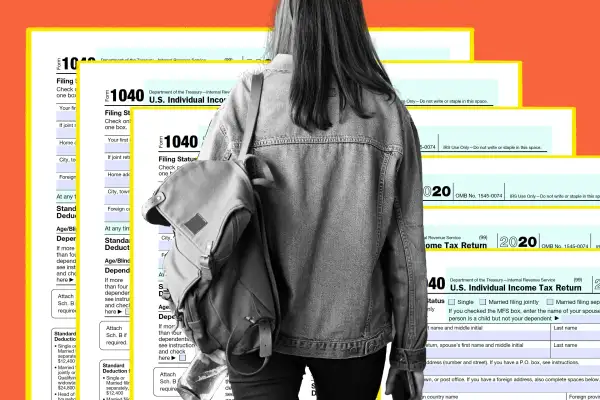You Can Deduct Student Loan Interest on Your 2020 Taxes Even if You Skipped Payments Last Year

As with most types of debt, the interest on student loans can make it difficult to cut away at your principal balance. But unlike a lot of other types of debt, there is a tiny silver lining with student loan interest: it’s tax deductible.
Each year more than 12 million Americans get a little boost on their taxes thanks to the student loan interest tax deduction. It’s an “above-the-line” deduction, or in the terms of the IRS, an adjustment to income, which means you don’t have to itemize your taxes to claim it. You can subtract up to $2,500 of interest paid each year from your taxable income.
But for the 2020 tax year, this deduction will look different for many federal student loan borrowers, who haven’t been required to make payments for much of last year. Here’s what to know.
How Does the Deduction Change for Federal Borrowers This Year?
More that 35 million federal student loan borrowers have been in an interest-free forbearance period since mid-March. The value of the student loan interest deduction this year will be a lot smaller for most of those borrowers.
Instead of claiming the total interest paid over a 12-month period, most borrowers have only paid interest for January, February and the beginning of March, before the CARES Act set interest rates to 0%.
Loans servicers typically send borrowers a form, called a 1098-E, that outlines how much interest was paid. But the servicers are only required to send it if your interest totaled more than $600. So while you may be used to automatically getting this form each January in your mailbox or inbox, keep in mind that this year, you might have to proactively request it, since you’ve paid about a quarter of the interest that you did last year.
Who Can Still Get the Full Student Loan Interest Deduction for 2020?
There are still plenty of people who can claim the full interest deduction this year. There are millions of borrowers with private student loans who weren’t granted any relief on their interest rates this year, though some may have gotten temporary hardship forbearances from their lenders.
There are also millions of borrowers with older federal loans that did not qualify for the relief in the CARES Act. That includes borrowers in the Federal Family Education Loan (FFEL) program, through which the government backed loans that are actually owned by commercial lenders, and those with Perkins Loans, some of which are owned by colleges.
There are also income cutoffs to qualify for the maximum value of the deduction. If you’re a single filer, you need a modified adjusted gross income of $70,000 or less. If you’re married and filing jointly, the cutoff is $140,000. Borrowers earning up to $85,000 (single) or $170,000 (married) can qualify for a partial deduction. (Those income limits are based on the IRS’s most recent guidelines, but the agency hasn’t released a 2020 update yet.)
Loans that count toward the deduction include any loan used to pay for an eligible student (you, a spouse or a dependent) for qualified education expenses, such as tuition, fees, books, supplies, and room and board, at an eligible institution.
Finally, there are a few other stipulations to be able to claim this deduction, including that your filing status isn’t married filing separately and that you can’t be claimed as a dependent on another person’s taxes. You also can’t claim the deduction for payments you made on someone else’s behalf (like a parent helping a child pay off debt).
If you’re unsure if you qualify for the deduction, the IRS has an interactive tool to determine if you can claim a deduction for student loan interest.
Who Benefits the Most from the Deduction?
Since this is a deduction as opposed to a tax credit (which reduces your tax bill dollar-for-dollar) it takes a little math to figure out how much the deduction is actually worth.
The maximum benefit from the student loan interest deduction is $550 this year, but the average amount — even in a typical year — is smaller. The average deduction is about $1,000 according to IRS data, which suggests that the average benefit is around $200, says Mark Kantrowitz, publisher of Savingforcollege.com.
The value of the deduction depends both on how much a borrower earns and how much interest they’re paying on their loans. Say a borrower has the average student loan balance of about $37,500 at 5% interest and is on a 10-year repayment plan. They’ll pay more than $10,250 in interest alone if they make only the minimum payments for the full repayment period.
That breaks down to roughly $1,800 in interest they could deduct in their first years of repayment. (As you continue reducing your principal, the amount of interest paid also declines.) If you earned $50,000 and paid $1,800 in interest, the deduction would save you $396.
Of course, there are millions of borrowers who have six-figure student debt balances, and plenty who have interest rates well above 5%. Private student loans often carry rates that are double that. Borrowers with large balances or high interest rates can more easily hit the $2,500 maximum deduction.
Finally, borrowers who are in higher tax brackets typically get the most savings from the deduction. Since they pay higher tax rates, lowering their taxable income translates to more savings. But because of the income cap, the majority of tax filers who claim the deduction earn under $100,000. Nearly two-thirds of the deductions are claimed by taxpayers earning between $30,000 and $99,999, according to an analysis by Credible.
More from Money:
Should You Keep Paying Your Student Loans Even If They Might Get Forgiven?
Student Loan Borrowers Just Received Another Month of Relief. Here's Why It Could Be Much Longer
The 3 Current Student Loan Forgiveness Proposals: Who Would Qualify?
